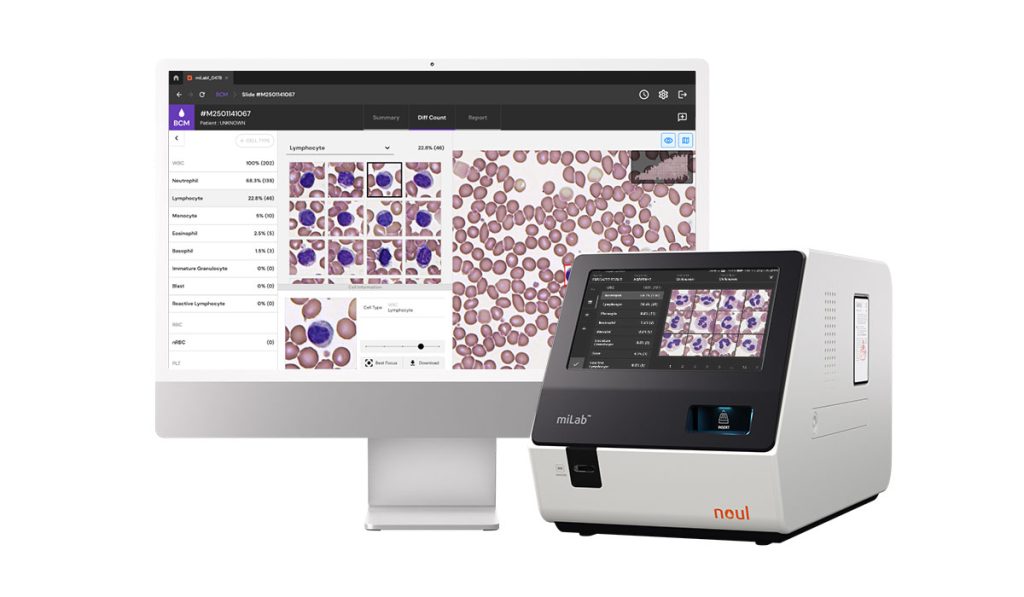During pregnancy, the body goes through several physiological changes. One important change is the natural shift in blood components. Most women have a Complete Blood Count (CBC) test early in their pregnancy. This test sets a baseline for normal CBC values. As pregnancy trimester progresses, the levels of white blood cells (WBCs), red blood cells (RBCs), hemoglobin, hematocrit, and platelets naturally change due to increased plasma volume and changes in the immune system.
These changes are well understood by doctors who use normal CBC values for each stage of pregnancy to monitor for any issues. Knowing how these values change during each trimester helps healthcare professionals spot potential complications early, such as anemia, infections, and clotting disorders.
In this article, we discuss how WBC and RBC levels change during pregnancy and highlight how new technologies, like NOUL’s miLab™, are making diagnostic tests faster and more accessible worldwide.
CBC Values by Trimester

Source: Freepik
Each person’s blood is made up of several components that support a healthy body. In pregnancy, these components are even more critical, as two people rely upon them. Pregnancy is split into three stages known as pregnancy trimesters; as each stage progresses, the normal CBC values begin to shift. Let’s take a closer look at each CBC value:
WBC Count in Pregnancy
White blood cells (WBCs) are responsible for fighting infections. With a greater risk of prenatal infection – to mother and child – the immune system adapts, increasing the proportion of WBCs within the blood.
*The sudden rise in WBCs postpartum is physiologically normal; however, given the potential infection risks, persistent elevations may require further evaluation.
RBC Count in Pregnancy
Red blood cells (RBCs) contain hemoglobin and carry oxygen from the lungs to the body’s tissues. During pregnancy, the RBC count gradually decreases as the plasma volume rises. (Plasma is the non-cellular part of the blood.) This process is known as hemodilution.
Given the increased demand for oxygen, monitoring the RBC count in pregnancy is crucial to detecting and managing iron-deficiency anemia. Women are commonly given iron supplements to counteract any deficiency.
Hemoglobin (Hb) and Hematocrit (Hct)
Hemoglobin (Hb) is a protein found in RBCs that transports oxygen. Usually, Hb levels are closely tied to the RBC count. So, as pregnancy progresses, Hb levels also decline slightly due to hemodilution.
Hematocrit isn’t a component of blood; it is a measurement of the percentage of RBCs in blood. For example, if your hematocrit is 40%, it means that 40% of your blood volume is made up of RBCs. It sees similar declines during pregnancy.
Persistently low levels of either hemoglobin or hematocrit aren’t always due to plasma volume expansions. Declines outside (or at the limits of) normal CBC ranges warrant closer clinical attention.
Platelets in Pregnancy
Platelets are responsible for blood clotting. During labor, they’re crucial for preventing excessive bleeding if any tearing occurs. Most women experience a mild decrease in platelets.
Challenges in Prenatal Testing in Low-Resource Settings

Source: Shutterstock
Monitoring changes in the WBC and RBC count in pregnancy is crucial to detecting and treating potential complications. Unfortunately, in low-resource settings in developing countries, access to routine care and diagnostics is often limited. The core problems involve a shortage of trained personnel, a lack of lab equipment, and complex processes.
Investing in an expensive laboratory and training the required staff is simply beyond the scope of what’s possible in many rural and semi-rural regions. Yet, without continuous monitoring, otherwise treatable problems go undiagnosed and untreated.
Why CBC Matters During Pregnancy
In Western nations, it’s easy to take routine tests, like a CBC, for granted. However, measuring these values gives medical professionals an insight into how pregnancy is progressing. For example, a steady decline in the RBC count in pregnancy tells us that the normal process of hemodilution is taking place. On the other hand, a sudden spike in the WBC count in pregnancy could indicate an infection.
As such, limited access to CBC testing means easily treatable conditions like anemia, infections, and coagulation disorders worsen until complications arise. The solution? Improving point-of-care diagnostics so that women in low-resource settings can readily access diagnostic tests, safeguarding maternal and fetal health.
How NOUL’s miLab™ Supports Prenatal Care

Source: NOUL
The miLab™ BCM is a portable, AI-powered CBC and morphology analysis developed by NOUL. It provides rapid, lab-quality analyses of blood samples, determining the levels of key blood components. In fact, it can analyze a blood sample in just a few minutes, providing accurate and reliable clinical information.
The miLab™ BCM doesn’t just measure blood components—it also examines the shape and structure of blood cells, providing both CBC and morphology insights in one seamless process. In doing so, it covers the full spectrum of blood analysis, from initial counts to detailed cellular evaluation.
The benefit? Well, the platform doesn’t require any advanced testing facilities or highly trained staff. Instead, its compact form, automated workflow, and high-precision digital microscopy allow almost anyone to use the device with minimal training anywhere in the world.
The miLab™ BCM delivers point-of-care diagnostics, making it an invaluable tool for maternal health programs, especially in rural clinics and resource-limited environments. Here, timely diagnostics can mean the difference between life and death, allowing local medical professionals to treat or refer patients much faster than before.
Already, it’s supporting early detection and fast clinical decision-making around the world. It’s bridging diagnostic gaps in prenatal care.
NOUL at SFH 2025

Source: Linkedin – NOUL
NOUL showcased its impressive miLab™ BCM platform at the recent SFH 2025 conference, held from April 2-4 at Palais des Congrès in Paris, France (booth #34b). It was an incredible opportunity to speak to global hematology experts, understand the pressing challenges in maternal health and other issues, and learn how our innovative platform can help.
We presented the platform’s capabilities in CBC and morphology analysis, demonstrating the immense power of AI automation in diagnostics. This doesn’t just open the door to diagnostics in remote locations, but it can enhance the efficiency of existing diagnostic infrastructure. With millions of people unable to access hospitals and modern diagnostics, the miLab™ is a viable solution – bringing reliable, life-saving CBC testing to expectant mothers.
Conclusion
The role of RBC and WBC counts in pregnancy cannot be overstated. They’re a simple, affordable test that provides crucial insights into how the body changes across each pregnancy trimester.
New advanced tools like NOUL’s miLab™ BCM offer a faster, more reliable diagnostic solution for mothers in rural and resource-deprived regions. NOUL is committed to expanding our reach delivering life-saving medical diagnostics throughout the world.
Ready to learn more? Contact NOUL today to find out more about the miLab™ BCM and how it can support your prenatal care efforts.

